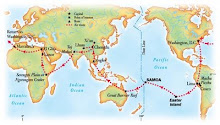February 2, 2017
Happy Groundhog Day! No news yet if the groundhog saw his shadow aboard the Viking Sea. Doesn't really matter because, as we write this blog post, we are at sea with abundant sun and temperatures in the 60's.
In general our family is very supportive of our travel, even the out of the way places we venture to. However, heading to Tunis, we heard from several family members with concerns about our safety based on a terrorist attack in Tunis in 2015 and a current travel advisory for Brits and Americans about travel to Tunisia. To be perfectly honest, we had forgotten about the attack before we booked this cruise so we had no fears. Rest assured we are always vigilant. Obviously Tunisia is concerned about our safety as we had a police escort from one tour stop to another with police along the way stopping traffic for us and there was very obvious police presence at each of our tour stops. Our first stop on Tuesday was the Bardo Museum. When Tunisia was granted its independence in the 1950's, the palace that was the home of the Beys (kings) was turned into a museum. Our guide told us it would take three days to see everything in the museum so he was only going to show us the important stuff. The cliff notes of museum visits. What we saw was an impressive array of mosaics from as early as before Christ. These mosaics were made out of marble pieces stained with vegetable oil to give them color. There were also a few ceramic mosaics from the period when the Turks were in control of Tunisia. None of the mosaics were original to the palace/museum. As impressive as the mosaics were, maybe more impressive was the technique for removing them from their original locations for transfer to the Bardo Museum. A process was developed where just the top several inches of the mosaic were cut, creating a long sheet of mosaic. A substance was applied to the mosaic and then allowed to dry so that the mosaic had enough flexibility to be rolled up making transportation to the museum easy. Once the mosaic was put in place at the Bardo, another substance was used to remove the original substance and, viola, the mosaic looked like it had been installed originally in the museum.
From the Bardo Museum we were bused to the Medina in the oldest part of Tunis. The Medina was similar to markets, souks, and bazaars that we have visited in other cities. There were lots of jewelry stores, rug shops, and shops selling scarves and such. Of particular interest were several shop displays of wedding dresses as well as attire for the groom. Both pieces of clothing were in white. Lynda thoroughly enjoyed bartering with shopkeepers for the things she purchased.
After a very interesting lunch that we will make no attempt to describe, we went to Carthage. There are very few ruins left from the time that Carthage ruled the Mediterranean. Carthage is located right on the sea on what is now prime real estate so that every time archaeologists try to do a dig, some multi-millionaire is able block their efforts. What little we saw was impressive.
Our last stop of the day was Cidi Bou Said, a town located near Carthage. In the 1890's into the 1900's Cidi Bou Said became a popular colony for artists including Gustave Flaubert and Paul Klee. The town is now noteworthy because it is required that all buildings in Cidi Bou Said be painted white with the same color blue trim. The local Ace Hardware is making a killing on blue paint. We were given the opportunity to walk around the town, but encountered the same souvenir shops we saw outside the Medina. However, we must say the buildings were beautiful.
Wednesday (today) we were in Cagliari, the capital of Sardinia. Over its long history it has been under the control of many countries and empires including the Vandals, the Spanish, and the Austrians. It is now part of Italy. About the only thing of interest that we saw on our three and a half hour tour was the Cathedral of Santa Maria. This cathedral was built in the Roman-Norman style, but when Spain took control it was redone in a very ornate Baroque style. Quite lovely. The only other fact of note that we did not know was that Sardinia was of strategic importance during World War II. Because of its position midway between Malta and Gibraltar it was of importance to the Italian military in their defense of the south of Europe. Sardinia was actually called the "aircraft carrier of the Italian Navy" As such, Sardinia suffered heavy bombing damage from the allies during the war.











2 comments:
Does mom purchase things just so she can have an excuse to barter with the locals?
Not really...but it is entertaining. 😉
Post a Comment